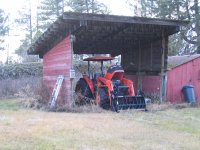pmsmechanic
Elite Member
- Joined
- Dec 6, 2013
- Messages
- 4,395
- Location
- Southern Alberta, Canada
- Tractor
- 4410 and F-935 John Deere, MF 245
The reason I do not like crushed rock inside a hole with a post is that it gives water a place to go to. Virgin soil around the hole is harder and then inside the hole. By creating gaps inside the hole with rocks, you provide a place for water to gravitate to, and remain for extended periods of time. If there was no rock in the hole, no water would go into the hole.
I agree with you on this. My theory is that at least with crushed rock the water can also percolate back into the soil. When there is cement around the post it's like setting a post into a bucket of water.
I got the idea form the power company's around here. They set power poles into the holes with crushed rock. I said if it was good enough for them it was good enough for me. And I really like the self tightening properties of crushed rock.

